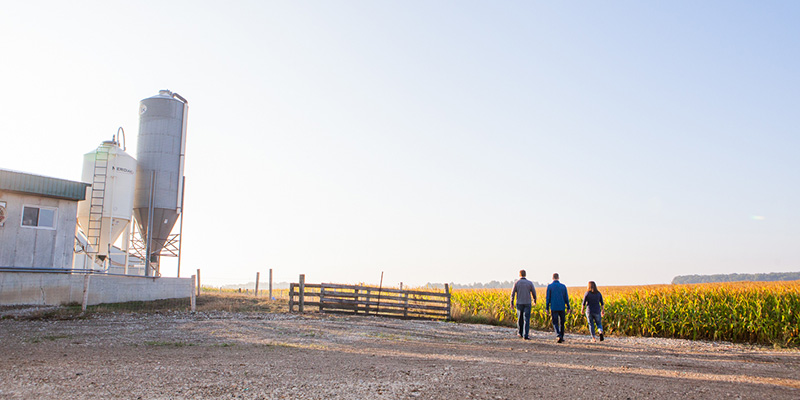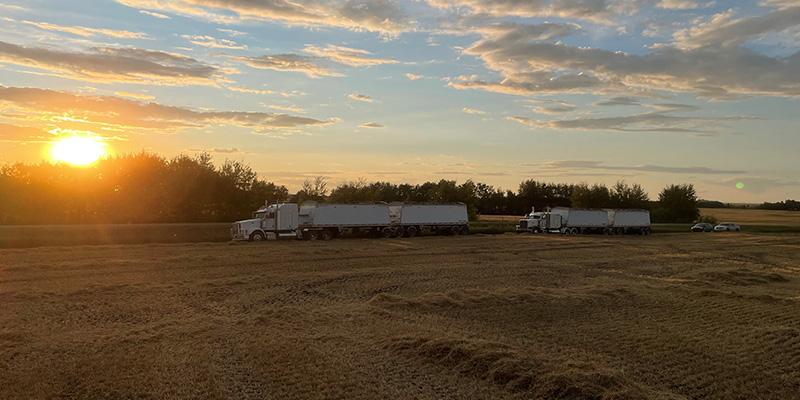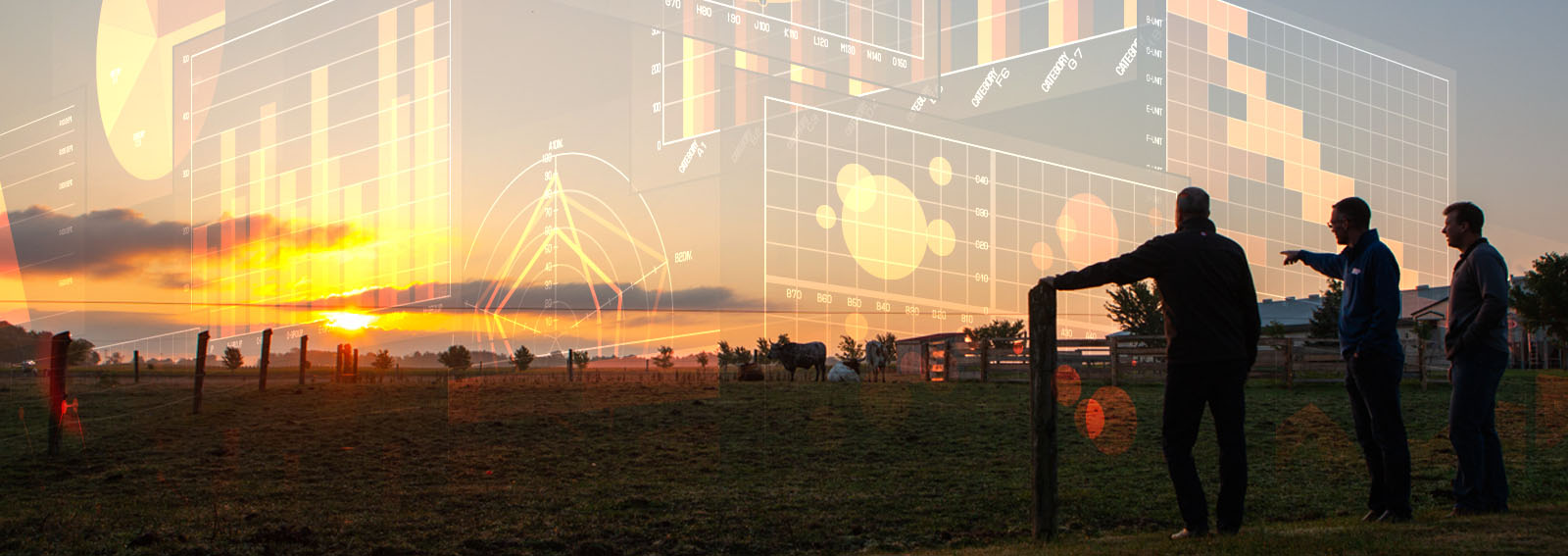Table of contents
- What technology is used in farming?
- What are the benefits of using more technology on the farm?
- What’s the first step to integrating technology?
- Who has access to my farm data?
- How is farm data and technology used in farming?
- Technology in action: Field optimization
- Digital benchmarking: Compare performance to your peers
Farmers have integrated technology into their day-to-day operations as well as any industry. But now, agriculture is in the middle of a major technological shift that has the potential to transform how you manage your farm and help to drive profitability.
Adopting digital technology tools on your farm can be daunting, especially if you have a well-established way of doing things. But the ability to understand your production, make better decisions, and unlock potential outweighs the growing pains.
We know you have questions about integrating technology into your farming operation and we’re here to help.
What technology is used in farming?
Agriculture is at the forefront of adopting and integrating technology to maximize their effectiveness. Over recent years, farmers have used a range of different tech options to help their operation.
Some essential examples are irrigation systems, automated machinery, and climate modelling. But the rapid pace of improvement in the agriculture technology means change is always around the corner.
The use of drones, powerful sensors, biotechnology, and robotics is creating a fundamental shift in the day-to-day operations of farmers in all areas.
A major technology opportunity for farmers is leveraging the data they create to operate more efficiently and effectively.
What are the benefits of using more technology on the farm?
Adopting technology can help farmers in every niche. It’s a cliché, but technology allows you to work smarter, not harder. You can get more out of the effort you put in and manage risks more effectively.
The specific benefits vary from farm to farm. Here are some examples:
- Smart-crop monitoring uses sensor equipment to ensure you’re using the right resources at the right time.
- Improved data analysis of soil conditions, weather, and crop growth can help you optimize your crop management plans.
- Autonomous farming machinery can improve your yield by using sensors and adjusting to any challenges.
- Livestock monitoring can detect illness early and identify animals that may need extra support.
- Farmers can use financial management and analysis tools to better track expenses and revenue, allowing you to see high-cost areas or adjust your pricing and marketing.

Plan to be more profitable
Data can help you make proactive and informed decisions to benefit your farming operation and overcome the current challenges facing your industry.
What’s the first step to integrating technology?
Many farmers have a strong foundation for integrating technology: data. Every day, you could be creating and storing vast amounts of data that could be analyzed and implemented into your decision-making process if you adopt the right tools.
Some operations are more ready than others. To understand if you’re ready, think about the following areas:
- Data Collection: Farmers should ensure that they’re collecting the right data consistently and accurately. This can involve using standardized data collection forms, using electronic sensors, and other technologies to automate data collection.
- Data Quality: The quality of data is crucial for accurate analysis. Are you confident that your data is complete, accurate, and reliable? Missing or inaccurate data can lead to flawed analysis and poor decision-making.
- Data Organization: The data should be organized in a way that is easy to analyze. This can involve structuring the data into tables or spreadsheets, and using consistent naming conventions for fields and variables.
- Data Cleaning: Data cleaning involves identifying and correcting errors in the data. This can include removing duplicates, fixing formatting issues, and identifying and correcting outliers.
- Data Transformation: Data transformation involves converting the data into a format that is suitable for analysis. This can include calculating summary statistics, creating new variables, and aggregating data at different levels (e.g. by day, week, or month).
Thinking about these areas can be overwhelming and that’s OK. Advisors can help you understand where you stand in the technology adoption journey and support you in preparing your farming operation to prepare data effectively.
Is your farm data ready for analysis?
Who has access to my farm data?
One of the concerns we hear from farmers is that their data could be accessed by third parties without their knowledge.
The data that you generate is only shared with third parties that you authorize. Some farmers share the data with their advisors for support interpreting the information and getting guidance for their operations.
How is farm data and technology used in farming?
Once you’ve prepared your data, it’s time to put it use. Here are some areas where you can apply learnings from data to improve performance:
- Crop Management: You can use data on soil conditions, weather, and crop growth to optimize their crop management practices. This can involve adjusting fertilizer and water applications, choosing the right crop varieties, and identifying areas that need special attention.
- Resource Management: Data on resource use, such as water, fuel, and labour, can help you optimize your resource management practices. You’ll be able to identify inefficiencies in resource use, reduce waste, and improve productivity.
- Financial Management: You can use financial data to track expenses and revenue, identify your costs, and optimize pricing and marketing strategies. This can help improve profitability and reduce financial risk.
- Risk Management: Data can be used to identify and mitigate various types of risk, such as crop failure, weather events, and market fluctuations. Identifying areas of risk and developing strategies to manage is a strong mitigation approach.
- Environmental Management: Applying learnings from data on environmental factors, such as water quality, air quality, and biodiversity, can help you make decisions that promote environmental sustainability. This can involve identifying areas of environmental risk, implementing conservation practices, and monitoring the impact of farming practices on the environment.
Where you focus your efforts depends on the unique challenges facing your farm. Advisors can help you build a digital strategy that reflects your biggest areas of needs.

Subscribe to the MNP’s Agriculture Business Insights Newsletter
Sign up to receive regular notification of agriculture related news and insights that matter most to you and your farm.
Technology in action: Field optimization
Having the right information at the right time is crucial for making good decisions. Field optimization is the process of using technology to understand the health and welfare of your crop, identifying where you’re succeeding and where you may want to improve. The tech compares your performance to others growing similar crops.
To make these judgements, you’ll use technology to analyze the data you’ve collected. You can analyze the common activities that take place on a field and look at when, where, and how those activities took place. You can also incorporate multiple factors proven to influence how a plant moves to its growing cycle year over year, like rainfall, evaporation, average temperature, and even crop damage that may occur.
A machine learning model takes these data points and optimizes each common activity to determine how you could have increased your yield.
Integrating a field optimization approach to your operation allows you to make significantly more informed decisions and easily identify opportunities for improvement.
Digital benchmarking: Compare performance to your peers
Digital benchmarking in agriculture is a process that involves comparing and analyzing data from multiple farms or farming operations to identify best practices and areas for improvement. It involves using digital technologies, such as farm management software, sensors, and other data collection tools, to collect and analyze data from multiple farms.
The data collected can include information on crop yields, resource use (such as water, fertilizer, and energy), labor productivity, financial performance, and environmental impact. By comparing this data across farms, digital benchmarking can help farmers identify areas where they can improve their performance and adopt best practices from other farms.
Digital benchmarking can be done at different scales, from comparing data within a single farm operation to comparing data across entire regions or countries. It can also be used to compare data across different types of farming systems or to evaluate the impact of different management practices or technologies.
Overall, digital benchmarking in agriculture can be a powerful tool for improving farm performance and promoting sustainability. By comparing data across multiple farms and identifying best practices and areas for improvement, farmers can make data-driven decisions that can help them optimize their operations and achieve better outcomes.
Contact us
Shea is a Business Advisor with MNP’s Agricultural Services team in Saskatoon and the leader of the Firm’s Ag Digital initiative. Shea brings more than two decades of public practice experience to his role, working primarily with owner-operated agriculture businesses, including livestock-intensive farms.
Actively involved in running his family farm, Shea knows first-hand the issues faced by agricultural producers. Drawing on his extensive knowledge of agriculture, technology, and farm income programs, he helps clients manage their risk and identify unique opportunities for increased success. He helps create customized solutions for agricultural producers to positively impact profitability and help them achieve their business and personal goals.
Shea earned a Bachelor of Commerce (BComm) in accounting from the University of Saskatchewan in 1999. He is a Chartered Professional Accountant (CPA), qualifying as a Chartered Accountant (CA) in 2002.

